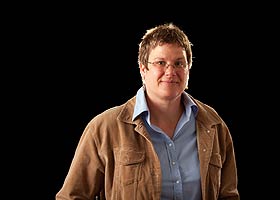
 Professor Astrid an Huef:
Professor Astrid an Huef:
She studies dynamical systems – mathematical objects intended to model the way things change.
Mathematics is both a pure science and art. Bertrand Russell, who was an outstanding pure mathematician before he gained his reputation as one of the world's leading philosophers, said that "Mathematics, rightly viewed, possesses not only truth, but supreme beauty''.
Professor Astrid an Huef (Department of Mathematics and Statistics) agrees and says she pursues mathematics for its beauty. An Huef says that it is the level of abstraction and attention to rigour that distinguish pure mathematicians from other scientists and, while she does have applications in mind for her work, they tend to be fairly theoretical in nature.
Mathematicians extract the intrinsic features common to several situations, develop a formalism describing these features and then study this formalism abstractly, forgetting all about the motivating situations.
This has several advantages: the unimportant features don't distract from the more important ones and ideas which work in the abstract formalism can eventually be applied to many more situations than originally envisaged (that's the hope, anyway).
Some formalisms have been studied for centuries and have become branches of mathematics: they are beautiful cohesive theories now studied by undergraduates in universities.
Other formalisms are forgotten, probably because of a lack of significant applications, but nothing is completely lost. Unlike lab sciences such as physics, old results are still correct and potentially useful no matter how long they lie around gathering dust in some library (metaphorical dust in today's electronic age!). For some mysterious reason, a mathematician's notion of beauty seems to be remarkably closely aligned with long-term utility across a range of applications.
An Huef studies dynamical systems – mathematical objects intended to model the way things change. These objects can be studied in a variety of ways and an Huef uses the techniques of infinite-dimensional algebra and analysis.
Most of her research in the area has focused on reversible systems, where you can go back and forward in time, which are mathematically very tractable. Recently she has also become interested in irreversible systems, which come from quite different situations and thus seem to have a different set of applications. For example, some of these irreversible systems come with sets of functions called “filter banks with perfect reconstruction'' used in signal processing, and other systems have their origin in number theory or graph theory.
In all cases, an Huef uses the dynamical system to build infinite-dimensional algebras and then she studies the symmetries of the system by studying the symmetries arising in the algebras. This technique goes back to the study in the 1930s of algebras of physical observables in quantum mechanical systems.
The most exciting moments in an Huef's research are the flashes of insight. She says that “insights usually come about by accident and realising the significance of a genuine insight is hindsight”. At the time she was just trying to understand what the basic underlying principles were!
Most mathematicians tend to work in pairs or groups, diversifying their knowledge by sharing. They thrive on interactions with colleagues, students and visitors. Most of an Huef 's research these days is done in collaboration with researchers from the UK, US, Australia and Brazil, often in front of a blackboard or whiteboard.
Funding
Australian Research Council